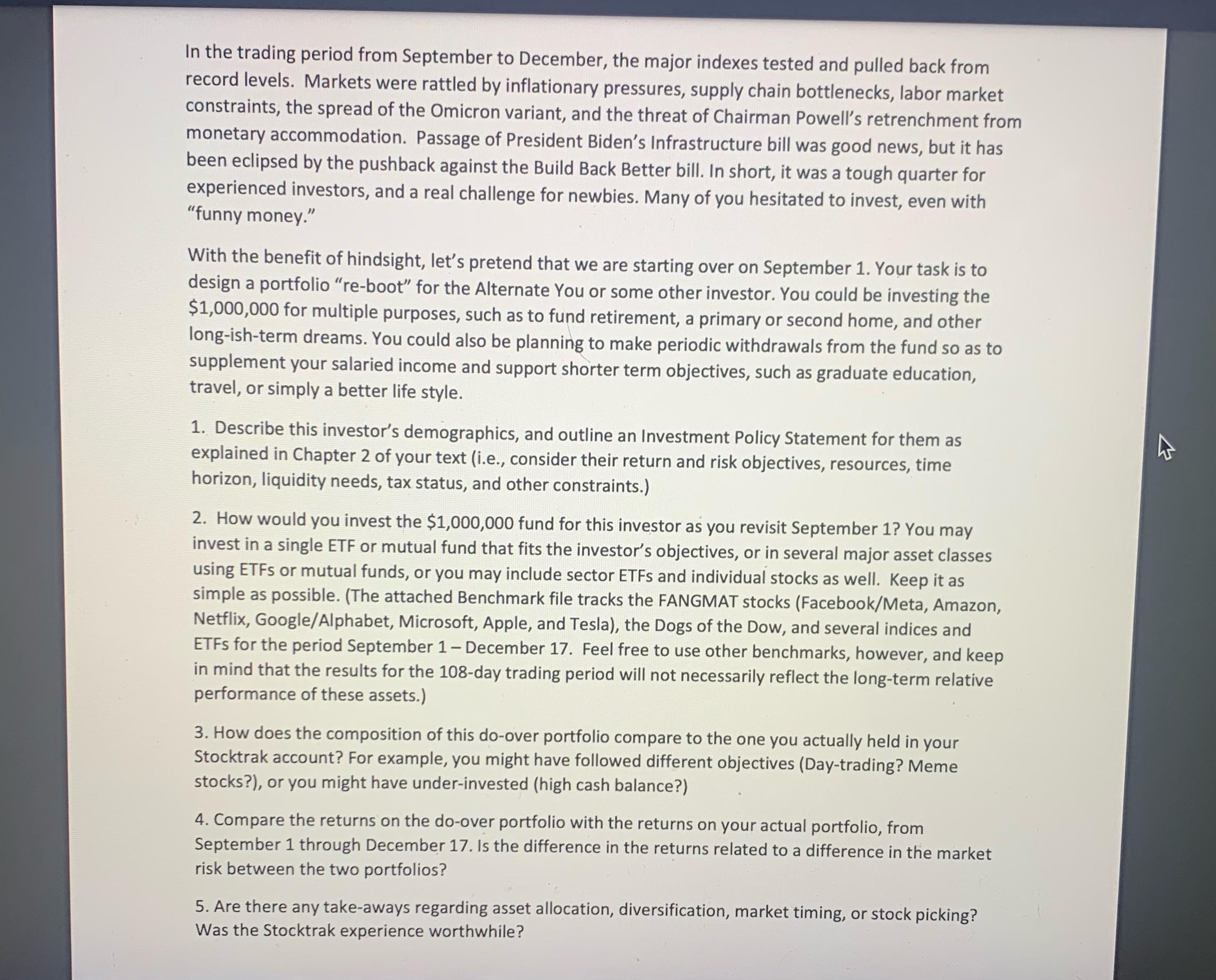Answered step by step
Verified Expert Solution
Question
1 Approved Answer
In the trading period from September to December, the major indexes tested and pulled back from record levels. Markets were rattled by inflationary pressures,

In the trading period from September to December, the major indexes tested and pulled back from record levels. Markets were rattled by inflationary pressures, supply chain bottlenecks, labor market constraints, the spread of the Omicron variant, and the threat of Chairman Powell's retrenchment from monetary accommodation. Passage of President Biden's Infrastructure bill was good news, but it has been eclipsed by the pushback against the Build Back Better bill. In short, it was a tough quarter for experienced investors, and a real challenge for newbies. Many of you hesitated to invest, even with "funny money." With the benefit of hindsight, let's pretend that we are starting over on September 1. Your task is to design a portfolio "re-boot" for the Alternate You or some other investor. You could be investing the $1,000,000 for multiple purposes, such as to fund retirement, a primary or second home, and other long-ish-term dreams. You could also be planning to make periodic withdrawals from the fund so as to supplement your salaried income and support shorter term objectives, such as graduate education, travel, or simply a better life style. 1. Describe this investor's demographics, and outline an Investment Policy Statement for them as explained in Chapter 2 of your text (i.e., consider their return and risk objectives, resources, time horizon, liquidity needs, tax status, and other constraints.) 2. How would you invest the $1,000,000 fund for this investor as you revisit September 1? You may invest in a single ETF or mutual fund that fits the investor's objectives, or in several major asset classes using ETFs or mutual funds, or you may include sector ETFs and individual stocks as well. Keep it as simple as possible. (The attached Benchmark file tracks the FANGMAT stocks (Facebook/Meta, Amazon, Netflix, Google/Alphabet, Microsoft, Apple, and Tesla), the Dogs of the Dow, and several indices and ETFs for the period September 1 - December 17. Feel free to use other benchmarks, however, and keep in mind that the results for the 108-day trading period will not necessarily reflect the long-term relative performance of these assets.) 3. How does the composition of this do-over portfolio compare to the one you actually held in your Stocktrak account? For example, you might have followed different objectives (Day-trading? Meme stocks?), or you might have under-invested (high cash balance?) 4. Compare the returns on the do-over portfolio with the returns on your actual portfolio, from September 1 through December 17. Is the difference in the returns related to a difference in the market risk between the two portfolios? 5. Are there any take-aways regarding asset allocation, diversification, market timing, or stock picking? Was the Stocktrak experience worthwhile?
Step by Step Solution
★★★★★
3.49 Rating (156 Votes )
There are 3 Steps involved in it
Step: 1
1 Investors Demographics and Investment Policy Statement Demographics The investor is in their mid30s married and has a stable job with a good income They have no immediate financial dependents but ar...
Get Instant Access to Expert-Tailored Solutions
See step-by-step solutions with expert insights and AI powered tools for academic success
Step: 2

Step: 3

Ace Your Homework with AI
Get the answers you need in no time with our AI-driven, step-by-step assistance
Get Started


